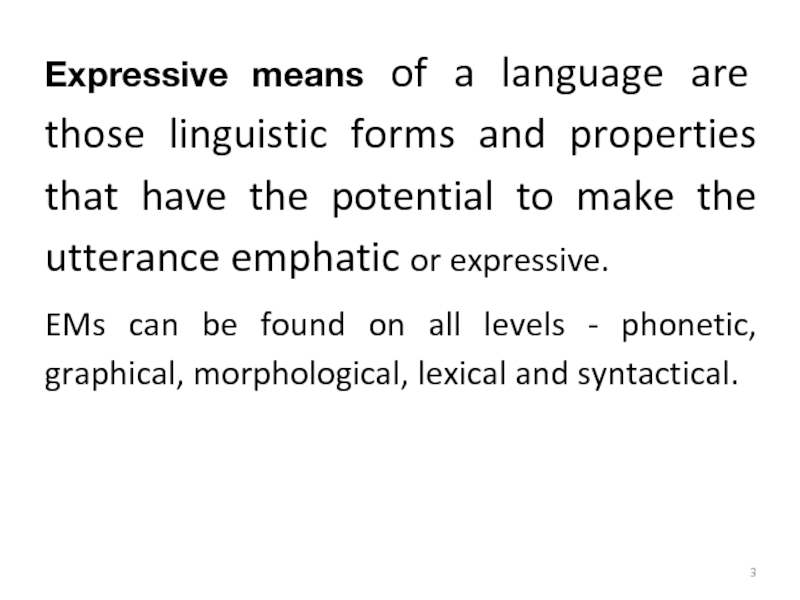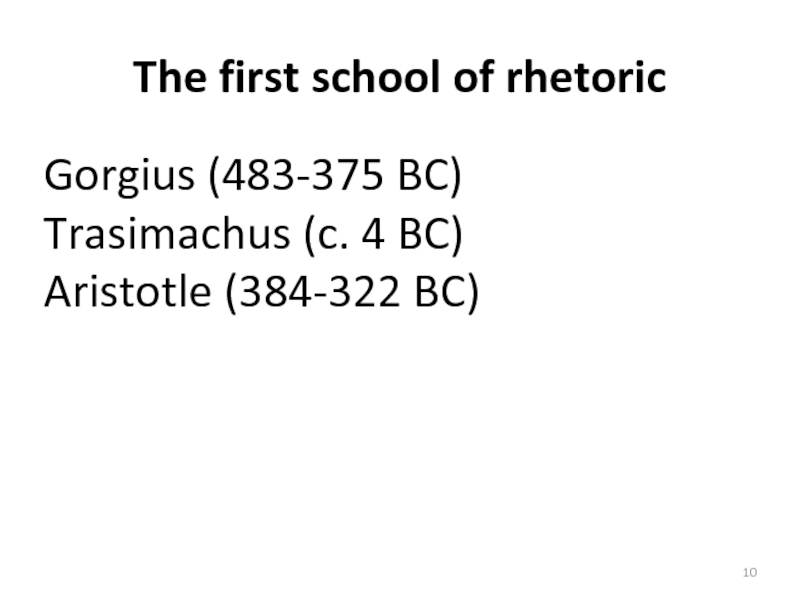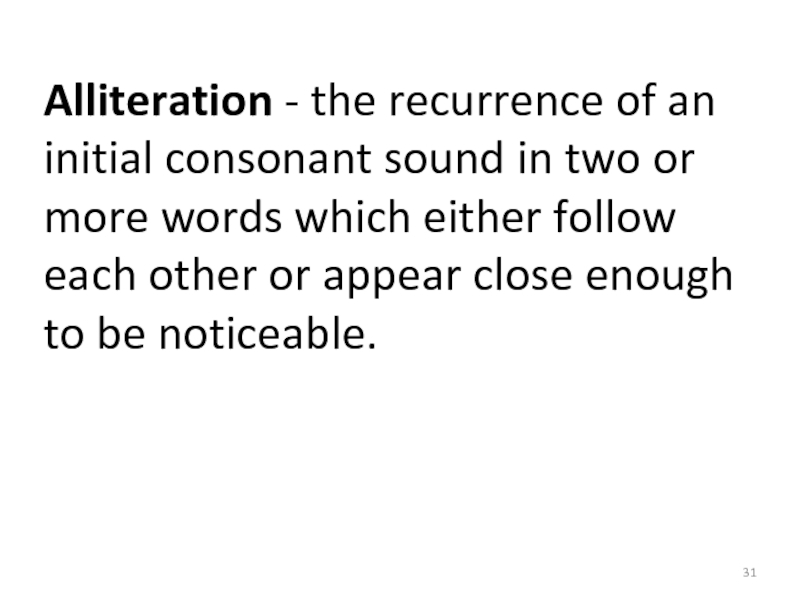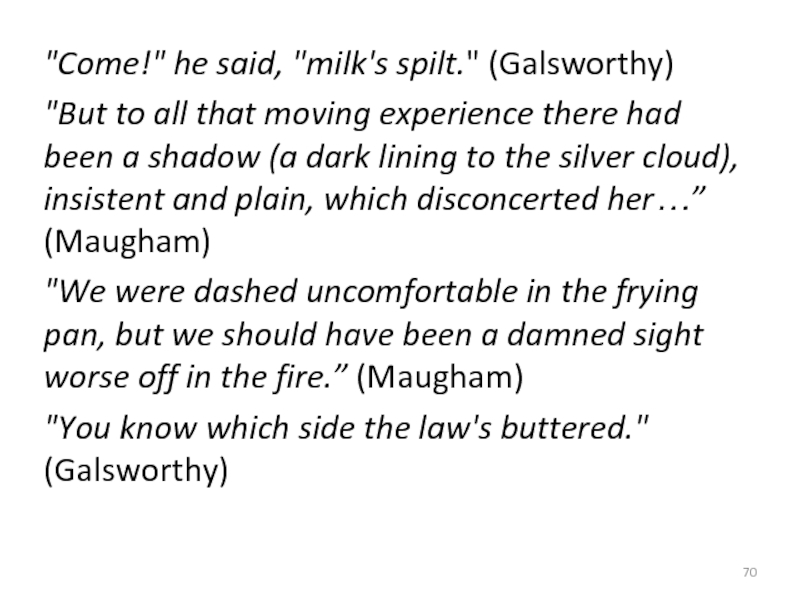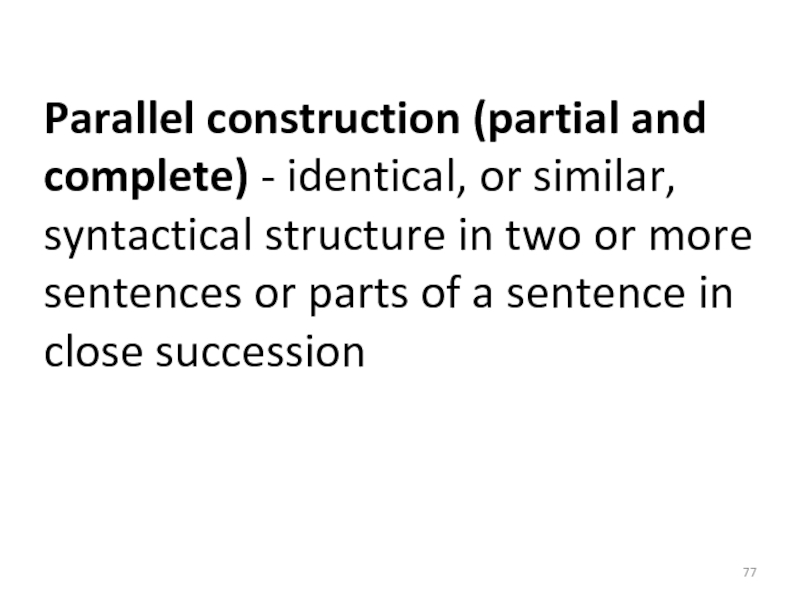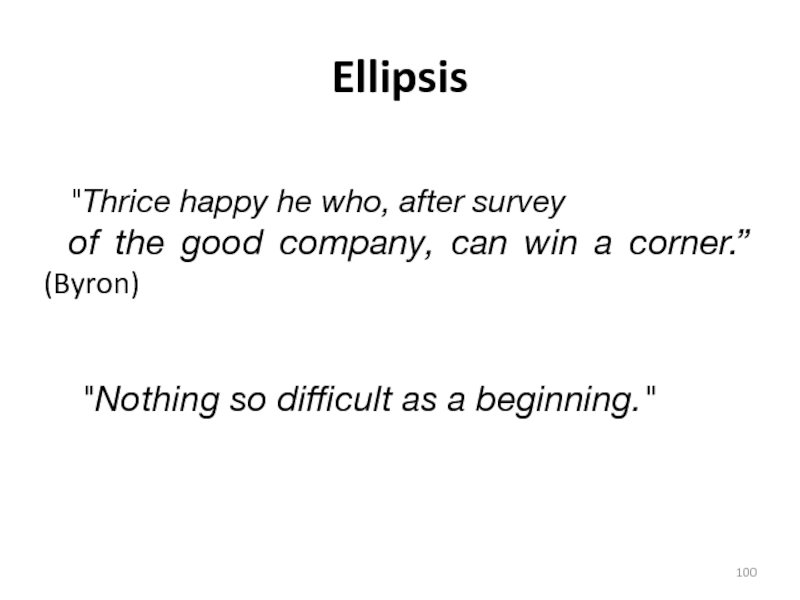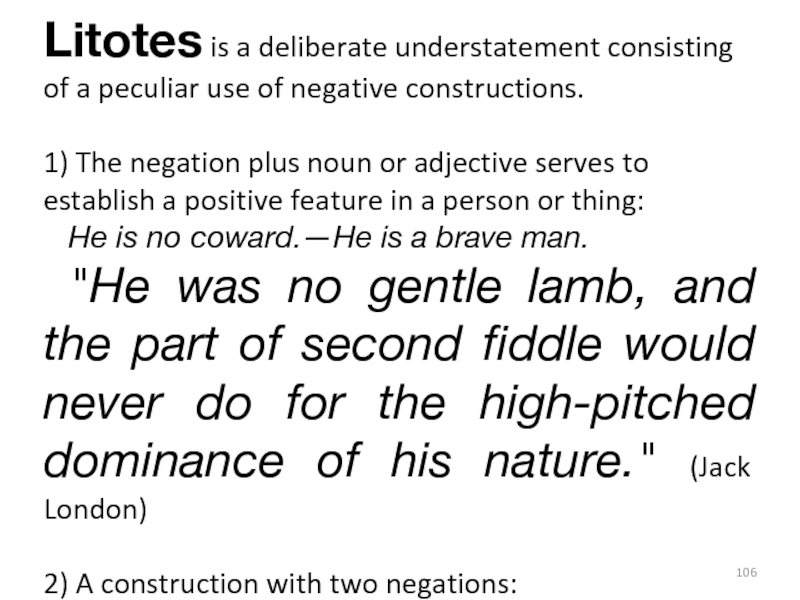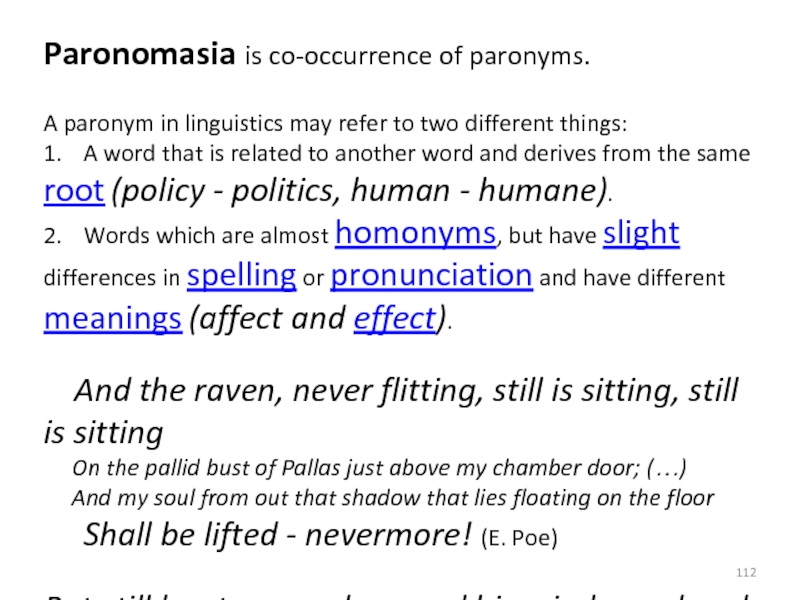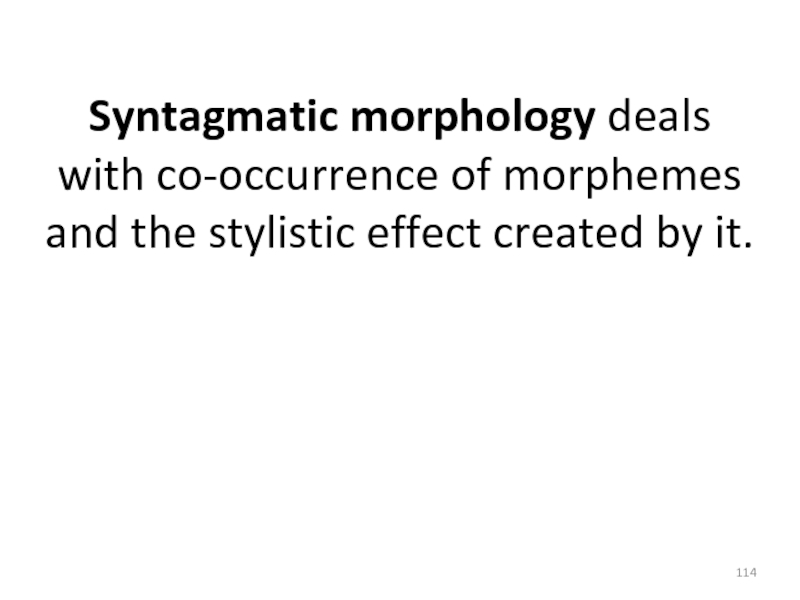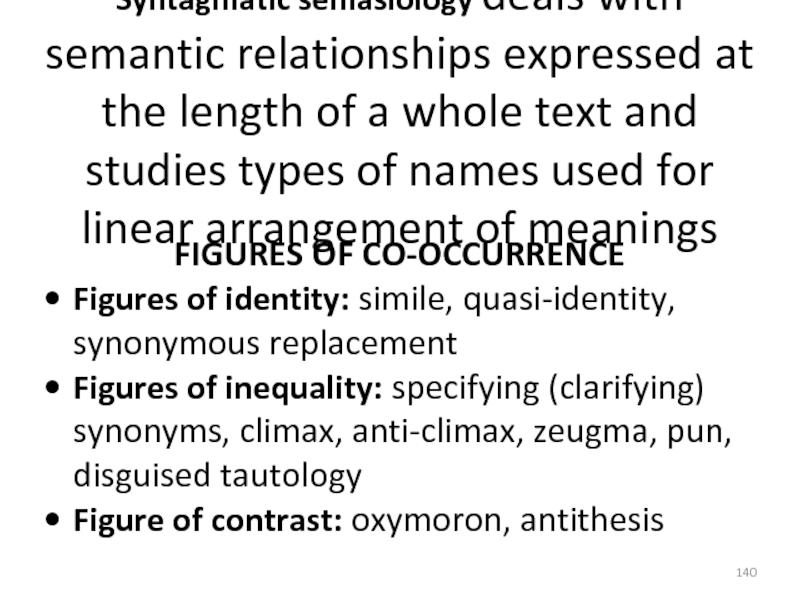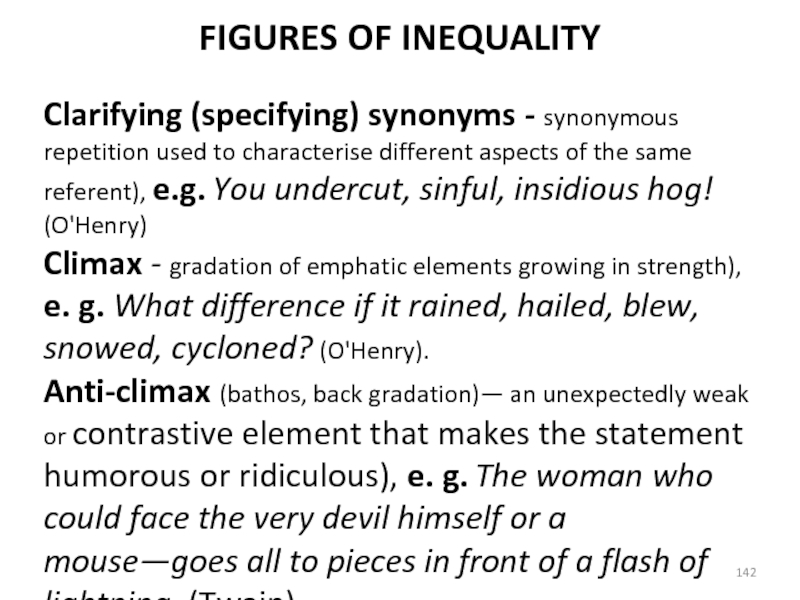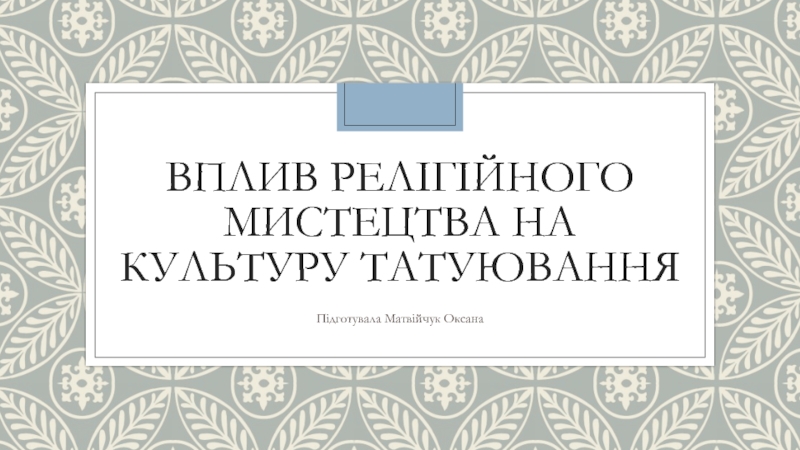- Главная
- Разное
- Дизайн
- Бизнес и предпринимательство
- Аналитика
- Образование
- Развлечения
- Красота и здоровье
- Финансы
- Государство
- Путешествия
- Спорт
- Недвижимость
- Армия
- Графика
- Культурология
- Еда и кулинария
- Лингвистика
- Английский язык
- Астрономия
- Алгебра
- Биология
- География
- Детские презентации
- Информатика
- История
- Литература
- Маркетинг
- Математика
- Медицина
- Менеджмент
- Музыка
- МХК
- Немецкий язык
- ОБЖ
- Обществознание
- Окружающий мир
- Педагогика
- Русский язык
- Технология
- Физика
- Философия
- Химия
- Шаблоны, картинки для презентаций
- Экология
- Экономика
- Юриспруденция
Classifications of expressive means and stylistic devices презентация
Содержание
- 1. Classifications of expressive means and stylistic devices
- 2. Expressive means (EMs) and stylistic devices (SDs)
- 3. Expressive means of a language are those
- 4. Phonetic EMs vocal pitch pauses sentence stress drawling or staccato pronunciation, etc.
- 5. Morphological EMs diminutive suffixes (e.g. girlie, dearie) nonce-words, etc.
- 6. Lexical EMs intensifiers, e.g. awfully, nicely, pretty, etc.
- 7. Syntactical EMs are special grammatical forms and
- 8. Graphical EMs capitalisation hyphenation italics, etc.
- 9. A stylistic device is a literary model
- 10. The first school of rhetoric Gorgius (483-375 BC) Trasimachus (c. 4 BC) Aristotle (384-322 BC)
- 11. The first theory of style included 3
- 12. Hellenistic Roman Rhetoric System tropes figures of speech that create rhythm types of speech
- 13. Tropes Metaphor Puzzle (riddle) Synecdoche Metonymy Catachresis (malapropism) Epithet Periphrasis Hyperbole Antonomasia
- 14. Figures of speech that create rhythm Figures
- 15. Figures that create rhythm by means
- 16. 3) Anaphora: repetition of a word
- 17. 4) Enjambment: running on of one thought
- 18. 5) Asyndeton: omission of conjunctions.
- 19. Figures based on compression 1) Zeugma
- 20. 2) Chiasmus: a reversal in the order
- 21. Figures based on assonance or accord
- 22. Figures based on opposition 1) Antithesis: choice
- 23. Types of speech flowery (florid) poetic normal dry scanty hackneyed tasteless
- 24. Stylistic theory by G. Leech Literature
- 25. Paradigmatic deviations occur when the author’s choice
- 26. A syntagmatic deviation is based on the
- 27. Geoffrey N. Leech. “A Linguistic Guide
- 28. Classification of EMs and SDs by
- 29. Phonetic EMs and SDs onomatopoeia alliteration rhyme rhythm
- 30. Onomatopoeia (sound imitation) Direct onomatopoeia: ding-dong, burr,
- 31. Alliteration - the recurrence of an initial
- 32. "The possessive instinct never stands still” (J.
- 33. Functions of alliteration consolidating effect (creating a
- 34. Rhyme is the repetition of identical or similar terminal sound combinations of words.
- 35. Types of rhyme Full rhyme (right-might, needless-heedless)
- 36. Arrangement of the rhymes within the stanza:
- 37. Two main functions of rhyme: dissevering consolidating
- 38. Rhythm is a flow, movement, procedure, etc.,
- 39. Lexical EMs and SDs Intentional mixing
- 40. Intentional mixing of the stylistic aspect of
- 41. Interaction of different types of lexical meaning
- 42. Interaction of primary dictionary and contextually imposed meanings Metaphor Metonymy Irony
- 43. Metaphor is a transfer of the name
- 44. Components of metaphor tenor (обозначаемое, референт) vehicle (обозначающее, агент) ground (основание)
- 45. Types of metaphor simple complex (sustained,
- 46. Types of metaphor (continued) dead
- 47. Metonymy is a transfer of the name
- 48. Types of relation in metonymy 1) A
- 49. Irony is a stylistic device also based
- 50. Interaction of primary and derivative logical meanings devices based on polysemantic effect zeugma pun
- 51. Zeugma - combining a polysemantic word with
- 52. Pun is ambiguity based on homonymy or
- 53. Interaction of logical and emotive meanings interjections and exclamatory words epithet oxymoron
- 54. Interjections radiate the emotional element over the
- 55. "Perhaps he won't. It's a long arduous
- 56. Epithet – a word, phrase or
- 57. Semantic classification of epithets Epithets associated with
- 58. Structural classification of epithets simple: wild wind
- 59. Oxymoron is created by ascribing a property
- 60. Interaction of logical and nominal meanings Antonomasia
- 61. EMs and SDs based on the intensification
- 62. Simile is an explicit statement concerning the
- 63. She can sing like a professional actress. She sings like a nightingale.
- 64. Periphrasis - a description of an object
- 65. Euphemism - a variety of periphrasis, a
- 66. Hyperbole - a deliberate overstatement or exaggeration
- 67. EMs and SDs based on the peculiar
- 68. A cliche is generally defined as an expression that has become hackneyed and trite.
- 69. Proverbs are brief statements showing in condensed
- 70. "Come!" he said, "milk's spilt." (Galsworthy)
- 71. Epigrams are terse, witty, pointed statements, showing
- 72. Decomposition of set phrases It was
- 73. Syntactical EMs and SDs Compositional patterns of
- 74. Compositional patterns of syntactical arrangement Stylistic inversion
- 75. Stylistic inversion: five main types 1. “Talent
- 76. Detached construction, parenthesis "Steyne rose up, grinding
- 77. Parallel construction (partial and complete) - identical,
- 78. “There were ... real silver spoons to
- 79. Chiasmus - a reversed parallel construction "As
- 80. Repetition Compositional patterns Anaphora "For that was
- 81. Framing "Poor doll’s dressmaker! How often so
- 82. Root-repetition "To live again in the youth
- 83. Functions of repetition To intensify the emotion:
- 84. Background repetition is sometimes used to
- 85. Enumeration is a stylistic device by which
- 86. Suspense is a compositional device which consists
- 87. Climax (gradation) is an arrangement of sentences
- 88. Logical climax is based on the relative
- 89. Emotional climax is based on the relative
- 90. Quantitative climax is an evident increase in
- 91. Anticlimax "In days of yore, a mighty
- 92. Antithesis "Youth is lovely, age is lonely,
- 93. Functions of antithesis rhythm-forming copulative dissevering comparative
- 94. Particular ways of combining parts of the utterance Asyndeton Polysyndeton Gap-sentence link
- 95. Asyndeton - a deliberate omission of the
- 96. Polysyndeton - connecting sentences, or phrases, or
- 97. Functions of polysyndeton: rhythmical disintegrating consolidating expressing sequence
- 98. Gap-sentence link is found if the connection
- 99. Particular use of colloquial constructions Ellipsis Break-in-the-narrative Question-in-the-narrative Represented speech
- 100. Ellipsis "Thrice happy he who, after
- 101. Break-in-the-narrative (aposiopesis) - a stopping short for
- 102. Question-in-the-narrative - a question that is asked
- 103. Represented speech “A maid came in now
- 104. Stylistic use of structural meaning Rhetorical questions Litotes
- 105. Rhetorical question reshapes the grammatical meaning of
- 106. Litotes is a deliberate understatement consisting of
- 107. Classification of expressive means and stylistic devices
- 108. STYLISTICS LEXICOLOGY
- 109. Paradigmatic phonetics actually describes phonographical stylistic features
- 110. Syntagmatic phonetics deals with prosodic features (intonation,
- 111. Assonance is an agreement (identity or similarity)
- 112. Paronomasia is co-occurrence of paronyms. A
- 113. Paradigmatic morphology observes the stylistic potentials of
- 114. Syntagmatic morphology deals with co-occurrence of morphemes and the stylistic effect created by it.
- 115. Paradigmatic lexicology subdivides English vocabulary into stylistic
- 116. Syntagmatic lexicology studies the «word-and-context» relations, e.g.
- 117. Paradigmatic syntax Sentences with deviations in the
- 118. Sentences with deviations in the quantitative characteristics
- 119. Ellipsis “Where is he?” – “Out
- 120. Aposiopesis and suppression KEITH (letting go her
- 121. One-member nominative sentences: London. Fog everywhere. Implacable
- 122. Sentences with deviations in the quantitative characteristics
- 123. Sentences with revaluation of syntactical meaning Quasi-affirmative
- 124. Sentences where various types of syntactical connections
- 125. Syntagmatic syntax deals with a chain of
- 126. Parallelism is a structural repetition of sentences
- 127. Epiphora (opposite of the anaphora, identical elements
- 128. Anadiplosis (the final element of one sentence,
- 129. Paradigmatic semasiology deals with transfer of names
- 130. Syntagmatic semasiology deals with semantic relationships expressed
- 131. FIGURES OF QUANTITY hyperbole - a deliberate
- 132. Litotes - expressing an idea by means
- 133. FIGURES OF QUALITY METONYMIC GROUP metonymy synecdoche periphrasis metonymic antonomasia
- 134. FIGURES OF QUALITY METAPHORIC GROUP metaphor personification allusion metaphoric antonomasia allegory
- 135. Personification is a particular case of metaphor.
- 136. An allusion is an indirect reference, by
- 137. Metaphorical antonomasia is the use of the
- 138. Allegory is a term in literature, or
- 139. FIGURE OF CONTRAST IRONY Irony is a
- 140. Syntagmatic semasiology deals with semantic relationships expressed
- 141. FIGURES OF IDENTITY Simile - an
- 142. FIGURES OF INEQUALITY Clarifying (specifying) synonyms -
- 143. FIGURES OF INEQUALITY (continued) Pun (play upon
- 144. FIGURES OF CONTRAST Oxymoron - a logical
- 145. Арнольд И. В. Стилистика. Современый английский язык.
Слайд 2Expressive means (EMs) and stylistic devices (SDs)
Hellenistic Roman rhetoric system
Stylistic theory
Classification of EMs and SDs by I. R. Galperin
Classification of EMs and SDs by Yu.M.Skrebnev
Classification of EMs and SDs by I. V. Arnold
Слайд 3Expressive means of a language are those linguistic forms and properties
EMs can be found on all levels - phonetic, graphical, morphological, lexical and syntactical.
Слайд 7Syntactical EMs are special grammatical forms and syntactical pattern attributing expressiveness.
E.g.: I do know you! I'm really angry with that dog of yours! That you should deceive me! If only I could help you!
Слайд 9A stylistic device is a literary model in which semantic and
SDs can be phonetic, morphological, lexical and syntactical.
SDs are also referred to as tropes or figures of speech.
Слайд 11The first theory of style included 3
subdivisions:
• the choice of words
• word
• figures of speech
Слайд 13Tropes
Metaphor
Puzzle (riddle)
Synecdoche
Metonymy
Catachresis (malapropism)
Epithet
Periphrasis
Hyperbole
Antonomasia
Слайд 14Figures of speech that create rhythm
Figures that create rhythm by means
Figures based on compression
Figures based on assonance or accord
Figures based on opposition
Слайд 15Figures that create rhythm
by means of addition
1) Doubling (reduplication, repetition)
E. g. Tip-top, helter-skelter, wishy-washy; oh, the dreary, dreary moorland.
2) Epenalepsis (polysyndeton): use of several conjunctions.
E. g. He thought, and thought, and thought; I hadn't realized until then how small the houses were, how small and mean the shops. (Shute)
Слайд 16
3) Anaphora: repetition of a word or words at the beginning
E.g. My heart’s in the Highlands, my heart is not here,
My heart’s in the Highlands, a-chasing the deer… (R. Burns)
Слайд 174) Enjambment: running on of one thought
into the next line without
the syntactical pattern.
E.g. April is the cruellest month, breeding
Lilacs out of the dead land, mixing
Memory and desire, stirring
Dull roots with spring rain.
Winter kept us warm, covering
Earth in forgetful snow, feeding
A little life with dried tubers. (T. S. Eliot)
Слайд 18
5) Asyndeton: omission of conjunctions.
E.g. He ran upstairs, rummaged in the
Слайд 19Figures based on compression
1) Zeugma (syllepsis): a figure by which a
E. g. He lost his hat and his temper, with weeping eyes and hearts.
Слайд 202) Chiasmus: a reversal in the order of words in one
E. g. He went to London, to Paris went she.
3) Ellipsis: omission of words needed to complete the construction or the sense.
E.g. The ringleader was hanged and his followers imprisoned.
Слайд 21Figures based on assonance or accord
1) Equality of colons.
2) Proportions and
Слайд 22Figures based on opposition
1) Antithesis: choice or arrangement of words that
E. g. It was the best of times, it was the worst of times, it was the age of wisdom, it was the age of foolishness.
2) Paradiastola: the lengthening of a syllable regularly short (in Greek poetry).
3) Anastrophe (inversion).
E. g. Me he restored, him he hanged.
Слайд 24Stylistic theory by G. Leech
Literature is the creative use of language.
The
Deviant features can be paradigmatic and syntagmatic.
Слайд 25Paradigmatic deviations occur when the author’s choice from equivalent items upsets
Examples:
“farmyards away”, “a grief ago”, “all sun long”
“As Connie had said, she handled just like any other aeroplane, except that she had better manners than most.”
Слайд 26A syntagmatic deviation is based on the opposite phenomenon: instead of
E.g. alliteration:
“Robert Rowley rolled a round roll round”
instead of
“Robert turned over a hoop in a circle”
Слайд 27
Geoffrey N. Leech. “A Linguistic Guide to English Poetry”. LONGMAN, London
Слайд 28Classification of EMs and SDs by
I. R. Galperin
Phonetic EMs and
Lexical EMs and SDs
Syntactical EMs and SDs
Слайд 30Onomatopoeia (sound imitation)
Direct onomatopoeia: ding-dong, burr, bang, cuckoo.
Indirect onomatopoeia: “And
Слайд 31Alliteration - the recurrence of an initial consonant sound in two
Слайд 32"The possessive instinct never stands still” (J. Galsworthy)
"Deep into
Слайд 33Functions of alliteration
consolidating effect (creating a compositional unity)
heightening the general aesthetic
imparting a melodic effect to the utterance
emphasis and mnemonic effects
Слайд 35Types of rhyme
Full rhyme (right-might, needless-heedless)
Incomplete rhyme
vowel rhyme (flesh - fresh
consonant rhyme (tale - tool)
compound or broken rhyme (upon her honour - won her)
eye-rhyme (love - prove, have - grave)
Слайд 36Arrangement of the rhymes within the stanza:
couplets - aa
triple rhymes -
cross rhymes - abab
frame or ring rhymes - abba
internal rhymes - ‘I bring fresh showers for the thirsting flowers’ (Shelley)
etc.
Слайд 38Rhythm is a flow, movement, procedure, etc., characterized by basically regular
Слайд 39Lexical EMs and SDs
Intentional mixing of the stylistic aspect of
Interaction of different types of lexical meaning
Intensification of a certain feature of a thing or phenomenon
Peculiar use of set expressions
Слайд 40Intentional mixing of the stylistic aspect of words
E. g. ‘Will you
Слайд 41Interaction of different types of lexical meaning
Interaction of primary dictionary and
Interaction of primary and derivative logical meanings
Interaction of logical and emotive meanings
Interaction of logical and nominal meanings
Слайд 43Metaphor is a transfer of the name of an object to
E.g. The machine sitting at the desk was no longer a man; it was a busy New York broker... (O.Henry).
Слайд 44Components of metaphor
tenor (обозначаемое, референт)
vehicle (обозначающее, агент)
ground (основание)
Слайд 45Types of metaphor
simple
complex (sustained, prolonged, extended)
E.g.: Mr.
Слайд 46Types of metaphor
(continued)
dead (trite) - leg of a table, hand
genuine (fresh)
Trite metaphors can be revived, e.g.: Mr. Pickwick bottled up his vengeance and corked it down.
Слайд 47Metonymy is a transfer of the name of an object to
Слайд 48Types of relation in metonymy
1) A concrete thing instead of an
2) The container instead of the thing contained: The hall applauded.
3) The relation of proximity: The round game table was boisterous and happy. (Dickens)
4) The material instead of the thing made of it: The marble spoke.
5) The instrument which the doer uses in performing the action instead of the action or the doer himself: As the sword is the worst argument that can be used, so should it be the last. (Byron)
Слайд 49Irony is a stylistic device also based on the simultaneous realization
E.g. (verbal irony):
It must be delightful to find oneself in a foreign country without a penny in one's pocket.
Слайд 50Interaction of primary and derivative logical meanings
devices based on polysemantic effect
zeugma
pun
Слайд 51Zeugma - combining a polysemantic word with two or more words
She possessed two false teeth and a sympathetic heart. (O. Henry)
At noon Mrs. Turpin would get out of bed and humour, put on kimono, airs and the water to boil for coffee. (O. Henry)
Слайд 52Pun is ambiguity based on homonymy or polysemy
OFFICER: What steps would
an enemy tank were approaching
towards you?
SOLDIER: Long ones.
Seven days without water make one weak/week.
Слайд 53Interaction of logical and emotive meanings
interjections and exclamatory words
epithet
oxymoron
Слайд 54Interjections radiate the emotional element over the whole of the utterance
Слайд 55"Perhaps he won't. It's a long arduous road he's starting to
"Hasn't it occurred to you? It seems to me that in what he said to you he indicated it pretty plainly. God."
"God!" she cried. But it was an exclamation of incredulous surprise. Our use of the same word, but in such a different sense, had a comic effect, so that we were obliged to laugh. But Isabel immediately grew serious again and I felt in her whole attitude something like fear.
Слайд 56
Epithet – a word, phrase or clause which is used attributively
Слайд 57Semantic classification of epithets
Epithets associated with the noun point at some
Epithets unassociated with the noun - attributes used to characterize the object by adding a feature not inherent in it, more unexpected and unusual (heart-burning smile, voiceless sands)
Слайд 58Structural classification of epithets
simple: wild wind
compound: heart-burning sigh, cloud-shapen giant
phrase or
reversed: the shadow of a smile, a devil of a job
transferred: a sleepless pillow, a disapproving finger, nervous cigarette-butts
Слайд 59Oxymoron is created by ascribing a property to an object incompatible,
meaning.
E.g. sweet sorrow, deafening silence
Слайд 60Interaction of logical and nominal meanings
Antonomasia - the use of the
E. g. Brutus (a traitor), Don Juan (a ladies’ man), Mr. Know-All, etc.
Слайд 61EMs and SDs based on the intensification of a certain feature
simile
periphrasis
euphemism
hyperbole
Слайд 62Simile is an explicit statement concerning the similarity, the affinity of
That fellow is like a bear.
She is as beautiful as a flower.
My heart is like a singing bird.
Слайд 64Periphrasis - a description of an object instead of its name
Delia
my better half (my wife)
the fair sex (women)
Слайд 65Euphemism - a variety of periphrasis, a word or phrase used
Слайд 66Hyperbole - a deliberate overstatement or exaggeration of a feature essential
He was so tall that I was not sure he had a face (O. Henry)
Слайд 67EMs and SDs based on the peculiar use of set expressions
The
Proverbs and sayings
Epigrams
Allusions
Decomposition of set phrases
Слайд 69Proverbs are brief statements showing in condensed form the accumulated life
Слайд 70"Come!" he said, "milk's spilt." (Galsworthy)
"But to all that moving
"We were dashed uncomfortable in the frying pan, but we should have been a damned sight worse off in the fire.” (Maugham)
"You know which side the law's buttered." (Galsworthy)
Слайд 71Epigrams are terse, witty, pointed statements, showing the ingenious turn of
An epigram is a stylistic device akin to a proverb, the only difference being that epigrams are coined by individuals whose names we know, while proverbs are the coinage of the people.
Слайд 72Decomposition of set phrases
It was raining cats and dogs, and two
Слайд 73Syntactical EMs and SDs
Compositional patterns of syntactical arrangement.
Particular ways of combining
Particular use of colloquial constructions.
Stylistic use of structural meaning.
Слайд 74Compositional patterns of syntactical arrangement
Stylistic inversion
Detached construction
Parallel construction
Chiasmus
Repetition
Enumeration
Suspense
Climax (gradation)
Antithesis
Слайд 75Stylistic inversion: five main types
1. “Talent Mr. Micawber has; capital Mr.
2. “With fingers weary and worn…” (Th. Hood)
“Once upon a midnight dreary…” (E. A. Poe)
3. a) “A good generous prayer it was.” (Mark Twain)
b) “Rude am I in my speech…” (Shakespeare)
4. “Eagerly I wished the morrow.” (Poe)
“My dearest daughter, at your feet I fall.” (Dryden)
“A tone of most extraordinary comparison Miss Tox said it in.” (Dickens)
5. “In went Mr. Pickwick.” (Dickens)
“Down dropped the breeze…” (Coleridge)
Слайд 76Detached construction, parenthesis
"Steyne rose up, grinding his teeth, pale, and with
"Sir Pitt came in first, very much flushed, and rather unsteady in his gait." (Thackeray)
"June stood in front, fending off this idle curiosity — a little bit of a thing, as somebody said, 'all hair and spirit'..."(Galsworthy)
Слайд 77Parallel construction (partial and complete) - identical, or similar, syntactical structure
Слайд 78“There were ... real silver spoons to stir the tea with,
"It is the mob that labour in your fields and serve in your houses—that man your navy and recruit your army,—that have enabled you to defy all the world, and can also defy you when neglect and calamity have driven them to despair." (Byron)
Слайд 79Chiasmus - a reversed parallel construction
"As high as we have mounted
In our dejection do we sink as low." (Wordsworth)
"Down dropped the breeze,
The sails dropped down" (Coleridge)
"The register of his burial was signed by the clergyman, the clerk, the undertaker and the chief mourner. Scrooge signed it. (Dickens)
Слайд 80Repetition
Compositional patterns
Anaphora
"For that was it! Ignorant of the long and stealthy
Epiphora
"I am exactly the man to be placed in a superior position in such a case as that. I am above the rest of mankind, in such a case as that. I can act with philosophy in such a case as that. (Dickens)
Слайд 81Framing
"Poor doll’s dressmaker! How often so dragged down by hands that
Anadiplosis
"Freeman and slave... earned on an uninterrupted, now hidden, now open fight, a fight that' each time ended, either in a revolutionary re-constitution of society at large, or in the common ruin of the contending classes."(Marx, Engels)
Chain repetition
"A smile would come into Mr. Pickwick's face: the smile extended into a laugh, the laugh into a roar, and the roar became general." (Dickens)
Слайд 82Root-repetition
"To live again in the youth of the young.” (Galsworthy)
"He loves
Synonymical repetition
"...are there not capital punishments sufficient in your statutes? Is there not blood enough upon your penal code!" (Byron)
Слайд 83Functions of repetition
To intensify the emotion:
"Stop!"—she cried, "Don't tell me! I
To express monotony:
"What has my life been? Fag and grind, fag and grind. Turn the wheel, turn the wheel.” (Dickens)
To express reiteration or continuity:
"Fledgeby knocked and rang, and Fledgeby rang and knocked, but no one came.”
"He played the tune over and over again.”
Слайд 84
Background repetition is sometimes used to stress the ordinarily unstressed elements
"I am attached to you. But I can't consent and won't consent and I never did consent and I never will consent to be lost in you." (Dickens)
Слайд 85Enumeration is a stylistic device by which separate things, objects, properties,
E. g.: ”The principal production of these towns... appear to be soldiers, sailors, Jews, chalk, shrimps, officers and dock-yard men.”(Dickens, "Pickwick Papers")
Слайд 86Suspense is a compositional device which consists in arranging the sentence
“ If you can keep your head when all about you
Are losing theirs and blaming it on you,
If you can trust yourself when all men doubt you
And make allowance for their doubting too,
If you can dream and not make dreams your master,
If you can think and not make thoughts your aim,
Yours is the earth and everything that's in it,...
And which is more, you'll be a Man, my son.”
(R. Kipling)
Слайд 87Climax (gradation) is an arrangement of sentences (or of the homogeneous
Types of climax
1) Logical
2) Emotional
3) Quantitative
Слайд 88Logical climax is based on the relative importance of the component
"Nobody ever stopped him in the street to say, with gladsome looks, 'My dear Scrooge, how are you? When will you come to see me?' No beggars implored him to bestow a trifle, no children asked him what it was o'clock, no man or woman ever once in all his life inquired the way to such and such a place, of Scrooge. Even the blind men's dogs appeared to know him, and when they saw him coming on, would tug their owners into doorways and up courts; and then would wag their tails, as though they said, 'No eye at all is better than an evil eye, dark master!’" (Ch. Dickens)
Слайд 89Emotional climax is based on the relative emotional tension produced by
"It was a lovely city, a beautiful city, a fair city, a veritable gem of a city.”
Слайд 90Quantitative climax is an evident increase in the volume of the
"They looked at hundreds of houses; they climbed thousands of stairs; they inspected innumerable kitchens." (Maugham)
"Little by little, bit by bit, and day by day, and year by year the baron got the worst of some disputed question." (Dickens)
Слайд 91Anticlimax
"In days of yore, a mighty rumbling was heard in a
Слайд 92Antithesis
"Youth is lovely, age is lonely,
Youth is fiery, age is frosty…”
"It was the best of times, it was the worst of times, it was the age of wisdom, it was the age of foolishness, it was the epoch of belief, it was the epoch of incredulity, if was the season of Light, it was the season of Darkness, it was the spring of hope, it was the winter of despair, We had everything before us, we had nothing before us, we were all going direct to Heaven, we are all going direct the other way..." (Dickens)
Слайд 95Asyndeton - a deliberate omission of the connective where it is
"Soames turned away; he had an utter disinclination for talk like one standing before an open grave, watching a coffin slowly lowered." (Galsworthy)
"Bicket did not answer his throat felt too dry." (Galsworthy)
Слайд 96Polysyndeton - connecting sentences, or phrases, or syntagms, or words by
"The heaviest rain, and snow, and hail, and sleet, could boast of the advantage over him in only one respect." (Dickens)
"Should you ask me, whence these stories?
Whence these legends and traditions, With the odours of the forest, With the dew, and damp of meadows, With the curling smoke of wigwams, With the rushing of great rivers, With their frequent repetitions,…" (Longfellow)
Слайд 98Gap-sentence link is found if the connection between two ideas is
"She and that fellow ought to be the sufferers, and they were in Italy" (Galsworthy)
"It was not Capetown, where people only frowned when they saw a black boy and a white girl. But here... And he loved her" (Abrahams)
Слайд 99Particular use of colloquial constructions
Ellipsis
Break-in-the-narrative
Question-in-the-narrative
Represented speech
Слайд 100Ellipsis
"Thrice happy he who, after survey
of the good company, can win
"Nothing so difficult as a beginning."
Слайд 101Break-in-the-narrative (aposiopesis) - a stopping short for rhetorical effect
"You just come
"Then, Mamma, I hardly like to let the words cross my lips, but they have wicked, wicked attractions out there—like dancing girls that—that charm snakes and dance without—Miss Moir with downcast eyes, broke off significantly and blushed, whilst the down on her upper lip quivered modestly." (Cronin)
“It depends”
“Good intentions but…”
Слайд 102Question-in-the-narrative - a question that is asked (and, as a rule,
“For what is left the poet here?
For Greeks a blush—for Greece a tear.” (Byron)
"How long must it go on? How long must we suffer? Where is the end? What is the end?" (Norris)
Слайд 103Represented speech
“A maid came in now with a blue gown very
"An idea had occurred to Soames. His cousin Jolyon was Irene's trustee, the first step would be to go down and see him at Robin Hill. Robin Hill! The odd—the very odd feeling those words brought back. Robin Hill—the house Bosinney had built for him and Irene—the house they had never lived in—the fatal house! And Jolyon lived there now! H'm!" (Galsworthy)
Слайд 105Rhetorical question reshapes the grammatical meaning of the interrogative sentence. Thus
They are utterances in the form of questions which pronounce judgements and also express various kinds of modal shades of meaning, as doubt, challenge, scorn, irony and so on.
E. g.: ”Who is here so vile that will not love his country?" (Shakespeare)
Слайд 106Litotes is a deliberate understatement consisting of a peculiar use of
1) The negation plus noun or adjective serves to establish a positive feature in a person or thing:
He is no coward.—He is a brave man.
"He was no gentle lamb, and the part of second fiddle would never do for the high-pitched dominance of his nature." (Jack London)
2) A construction with two negations:
"Soames, with his lips and his squared chin was not unlike a bull dog.” (Galsworthy)
Слайд 107Classification of expressive means and stylistic devices by Y. M.Skrebnev
Y. M.
Слайд 108
STYLISTICS
LEXICOLOGY
SYNTAX
SEMASIOLOGY
PHONETICS
MORPHOLOGY
LEXICOLOGY
SYNTAX
SEMASIOLOGY
PARADIGMATIC
SYNTAGMATIC
PHONETICS
MORPHOLOGY
Слайд 109Paradigmatic phonetics actually describes phonographical stylistic features of a written text.
graphons - graphic means to reproduce the phonetic peculiarities of individual speech or dialect, e.g.: Thquire!... Your thervant! Thith ith a bad pieth of bithnith, thith ith… (Ch. Dickens)
Other graphic means to emphasise the «unheard» phonetic characteristics such as the pitch of voice, the stress, and other melodic features, e.g. italics, capitalisation, repetition of letters.
Onomatopoeia
Слайд 110Syntagmatic phonetics deals with prosodic features (intonation, sentence stress, tempo) and
alliteration
assonance
paronomasia
rhythm and meter
rhyme
Слайд 111Assonance is an agreement (identity or similarity) of vowels in conjunction
E.g.: …Tell this soul, with sorrow laden, if within the distant Aiden, / I shall clasp a sainted maiden, whom the angels name Lenore - / Clasp a rare and radiant maiden, whom the angels name Lenore? (Poe)
Слайд 112Paronomasia is co-occurrence of paronyms.
A paronym in linguistics may refer to
1. A word that is related to another word and derives from the same root (policy - politics, human - humane).
2. Words which are almost homonyms, but have slight differences in spelling or pronunciation and have different meanings (affect and effect).
And the raven, never flitting, still is sitting, still is sitting
On the pallid bust of Pallas just above my chamber door; (…)
And my soul from out that shadow that lies floating on the floor
Shall be lifted - nevermore! (E. Poe)
But still he strummed on, and his mind wandered in and out of poultry and politics, Old Forsyte, Fleur, Foggartism and the Ferrar girl – like a man in a maelstrom whirling round with his head just above water. (J. Galsworthy)
Слайд 113Paradigmatic morphology observes the stylistic potentials of grammatical forms which G.
E. g.:
historical present
What else do I remember? Let me see.
There comes out of the cloud our house... (Dickens)
depersonification
«Where did you find it?» asked Mord Em'ly of Miss Gilliken with a satirical accent.
«Who are you calling "it"?» demanded Mr. Barden aggressively. «P'raps you'll kindly call me 'im and not it». (Partridge)
Слайд 114Syntagmatic morphology deals with co-occurrence of morphemes and the stylistic effect
Слайд 115Paradigmatic lexicology subdivides English vocabulary into stylistic layers.
Positive/elevated/superneutral
poetic;
official;
professional.
Bookish, archaic
Neutral
Negative/degraded/subneutral
colloquial;
jargon;
slang;
nonce-words;
vulgar words (lexical and stylistic vulgarisms).
Слайд 116Syntagmatic lexicology studies the «word-and-context» relations, e.g. those connected with co-occurrence
E.g.: Will you oblige me by keeping your trap shut, my dear?
Syntagmatic lexicology also studies simple lexical repetition.
E.g.: He thought and thought and thought it over and over and over.
Слайд 117Paradigmatic syntax
Sentences with deviations in the quantitative characteristics of sentence structure:
Sentences with deviations in the word order.
Sentences with revaluation of syntactical meaning.
Sentences where various types of syntactical connections are viewed stylistically.
Слайд 118Sentences with deviations in the quantitative characteristics of sentence structure: (A)
ellipsis
aposiopesis
suppression
one-member nominative sentences
morphologically incomplete sentences
asyndeton
Слайд 119Ellipsis
“Where is he?” – “Out in the garden.”
«He became one of
Слайд 120Aposiopesis and suppression
KEITH (letting go her arms): My God! If the
You heard what the guy said: get out or else. (Gardner)
Слайд 121One-member nominative sentences:
London. Fog everywhere. Implacable November weather. (Ch. Dickens)
Morphologically incomplete
I been waiting here all morning… (Robbins)
Fine class of friends you pick. (Robbins)
Слайд 122Sentences with deviations in the quantitative characteristics of sentence structure: (B)
1. Repetition of sentence parts
2. Syntactic tautology - (A) prolepsis, (B) tautology in appended statements):
A. Prolepsis: Miss Tillie Webster, she slept forty days and nights without waking up. (O. Henry)
B. Tautology in appended statements: I know what the like of you are, I do. (B. Shaw)
You’ve made a nice mess, you have. (Jerome)
3. Polysyndeton
Слайд 123Sentences with revaluation of syntactical meaning
Quasi-affirmative sentences: Isn't that too bad?
Quasi-interrogative sentences: Here you are to write down your age and birthplace = How old are you? Where were you born?
Quasi-negative sentences: Did I say a word about the money? (Shaw) = I did not say...
Quasi-imperative sentences: Here! Quick! — Come here! Be quick!
Слайд 124Sentences where various types of syntactical connections are viewed stylistically
«Smither should
«Talent, Mr. Micawber has, capital, Mr. Micawber has not» (Dickens)
«...he was struck by the thought (what devil’s whisper? - what evil hint of an evil spirit?) - supposing that he and Roberta - no, say he and Sondra - (no, Sondra could swim so well and so could he) - he and Roberta were in a small boat somewhere...» (Dreiser)
«Here is a long passage - what an enormous prospective I make of it! - leading from Peggoty ’s kitchen to the front door» (Dickens)
Слайд 125Syntagmatic syntax deals with a chain of sentences, the sequence of
parallelism
anaphora
epiphora
framing
anadiplosis
chiasmus
Слайд 126Parallelism is a structural repetition of sentences though often accompanied by
E. g. The cock is crowing,
The stream is flowing... (Wordsworth)
anaphora (identity of beginnings, initial elements).
E. g. If only little Edward were twenty, old enough to marry well and fend for himself, instead often. If only it were not necessary to provide a dowary for his daughter. If only his own debts were less. (Rutherfurd)
Слайд 127Epiphora (opposite of the anaphora, identical elements at the end of
E. g. For all averred, I had killed the bird. That made the breeze to blow. Ah wretch! Said they, the bird to slay, That made the breeze to blow! (Coleridge)
Framing (repetition of some element at the beginning and at the end of a sentence, paragraph or stanza).
E. g. Never wonder. By means of addition, subtraction, multiplication and division, settle everything somehow, and never wonder. (Dickens)
Слайд 128Anadiplosis (the final element of one sentence, paragraph, stanza is repeated
E. g. Three fishers went sailing out into the West. Out into the West, as the sun went down. (Kingsley)
Chiasmus (parallelism reversed, two parallel syntactical constructions contain a reversed order of their members).
E. g. That he sings and he sings, and for ever sings he— I love my Love and my Love loves me! (Coleridge)
Слайд 129Paradigmatic semasiology deals with transfer of names or what are traditionally
FIGURES OF REPLACEMENT
Figures of quantity: hyperbole, understatement (including litotes)
Figures of quality: metaphoric and metonymic group
Figure of contrast: irony
Слайд 130Syntagmatic semasiology deals with semantic relationships expressed at the length of
FIGURES OF CO-OCCURRENCE
Figures of identity: simile, quasi-identity, synonymous replacement
Figures of inequality: specifying (clarifying) synonyms, climax, anti-climax, zeugma, pun, disguised tautology
Figure of contrast: oxymoron, antithesis
Слайд 131FIGURES OF QUANTITY
hyperbole - a deliberate understatement, e.g.: One after another
understatement (meiosis) - toning down, understating the idea, e.g.: "We've got a few lights on Broadway, don't you think, Mr. Platt?”
“She sang listlessly as if she were bored with the whole thing, and the applause she collected could have been packed into a thimble, without overflowing." (Chase)
Слайд 132Litotes - expressing an idea by means of negating the opposite
"... she was not unlike Morgiana in the 'Forty Thieves'." (Dickens)
"And Captain Trevelyan was not overpleased about it." (Christie)
"A chiselled, ruddy face completed the not-unhandsome picture." (Pendelton)
"You wouldn't exactly call Warley heavily industrialized." (Braine)
"His suit... had... that elasticity disciplined only by first-rate tailoring which isn't bought for very much under thirty guineas." (Braine)
Слайд 134FIGURES OF QUALITY
METAPHORIC GROUP
metaphor
personification
allusion
metaphoric antonomasia
allegory
Слайд 135Personification is a particular case of metaphor. It consists in attributing
FORMAL MARKERS OF PERSONIFICATION
Capitalization: «No sleep till morn, when Youth and Pleasure meet To chase the glowing Hours with flying feet». (Byron)
Personal pronouns “he” and “she”: «Then Night, like some great loving mother, gently lays her hand at our fevered head... and, though she does not speak, we know what she would say...» (Jerome).
Direct address: «О stretch by reign, fair Peace, from shore to shore Till conquest cease, and slavery be no more». (A. Pope)
Слайд 136An allusion is an indirect reference, by word or phrase, to
“Don’t act like a Romeo in front of her.”
The rise in poverty will unlock the Pandora’s box of crimes.
“This place is like a Garden of Eden.”
“Hey! Guess who the new Newton of our school is?”
Слайд 137Metaphorical antonomasia is the use of the name of a historical,
E. g. Brutus (a traitor), Don Juan (a ladies’ man)
Слайд 138Allegory is a term in literature, or even in art in
E.g. fairy-tales, fables, philosophical or satirical novels (Gulliver’s Travels by Jonathan Swift)
Слайд 139FIGURE OF CONTRAST
IRONY
Irony is a transfer based upon the opposition of
E. g. “Never mind,” said the stranger, cutting the address very short, "said enough—no more; smart chap that cabman—handled his fives well; but if I'd been your friend in the green jemmy—damn me—punch his head— God I would— pig's whisper— pieman too,—no gammon.”
“This coherent speech was interrupted by the entrance of the Rochester coachman, to announce that…” (Dickens)
Слайд 140Syntagmatic semasiology deals with semantic relationships expressed at the length of
FIGURES OF CO-OCCURRENCE
Figures of identity: simile, quasi-identity, synonymous replacement
Figures of inequality: specifying (clarifying) synonyms, climax, anti-climax, zeugma, pun, disguised tautology
Figure of contrast: oxymoron, antithesis
Слайд 141
FIGURES OF IDENTITY
Simile - an explicit statement of partial identity: affinity,
Quasi-identity - a figure intermediate between metaphor and simile, or between metonymy and simile, with the structure TENOR IS VEHICLE.
E.g.: She is a real angel, Your brother is an ass (metaphoric quasi-identities), She was all angles and bones (Lee) (metonymic quasi-identity).
Synonymous replacement - the use of synonyms or synonymous phrases to avoid monotony or as situational substitutes.
E. g.: He brought home numberless prizes. He told his mother countless stories. (Thackeray)
Слайд 142FIGURES OF INEQUALITY
Clarifying (specifying) synonyms - synonymous repetition used to characterise
Climax - gradation of emphatic elements growing in strength),
e. g. What difference if it rained, hailed, blew, snowed, cycloned? (O'Henry).
Anti-climax (bathos, back gradation)— an unexpectedly weak or contrastive element that makes the statement humorous or ridiculous), e. g. The woman who could face the very devil himself or a mouse—goes all to pieces in front of a flash of lightning. (Twain)
Zeugma - a combination of unequal, or incompatible words based on the economy of syntactical units).
E. g. She dropped a tear and her pocket handkerchief. (Dickens)
Слайд 143FIGURES OF INEQUALITY
(continued)
Pun (play upon words based on polysemy or homonymy).
Disguised
E. g.:
And that’s that…
For East is East, and West is West... (Kipling)
Слайд 144FIGURES OF CONTRAST
Oxymoron - a logical collision of seemingly incompatible words.
E.
Antithesis - anti-statement, active confrontation of notions used to show the contradictory nature of the subject described.
E. g.: His fees were high, his lessons were light. (O'Henry)
Слайд 145Арнольд И. В. Стилистика. Современый английский язык. Учебник для вузов. М.,
Level-based classification of EMs and SDs (lexical, morphological, syntactical, phonetic and graphical level).
A great emphasis is laid on decoding stylistics, the terminology from the theory of information is applied.
SDs and EMs are studied on the basis of oppositions.
Text stylistics, context and intertextuality are discussed.


